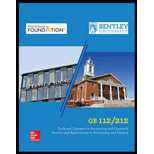
GB 112/212 MANAGERIAL ACC. W/ACCESS >C<
17th Edition
ISBN: 9781260218831
Author: Libby
Publisher: MCG CUSTOM
expand_more
expand_more
format_list_bulleted
Question
Chapter 10, Problem 1MCQ
To determine
Identify the correct answer related to interest expense of the bonds.
Expert Solution & Answer
Want to see the full answer?
Check out a sample textbook solution
Students have asked these similar questions
Can you solve this general accounting problem with appropriate steps and explanations?
Can you solve this financial accounting question with the appropriate financial analysis techniques?
Browno Company had no beginning inventory and adds all materials at the very beginning of its only process. Assume 26,750 units were started, and 12,400 units completed. The ending work in process is 76% complete. The equivalent units for conversion costs is _.
Chapter 10 Solutions
GB 112/212 MANAGERIAL ACC. W/ACCESS >C<
Ch. 10 - From the perspective of the issuer, what are some...Ch. 10 - What are the primary characteristics of a bond?...Ch. 10 - Prob. 3QCh. 10 - Differentiate between a bond indenture and a bond...Ch. 10 - Prob. 5QCh. 10 - Prob. 6QCh. 10 - Prob. 7QCh. 10 - Prob. 8QCh. 10 - What is the book value of a bond?Ch. 10 - Prob. 10Q
Ch. 10 - Prob. 11QCh. 10 - Prob. 12QCh. 10 - Prob. 1MCQCh. 10 - Prob. 2MCQCh. 10 - Prob. 3MCQCh. 10 - Prob. 4MCQCh. 10 - Prob. 5MCQCh. 10 - Prob. 6MCQCh. 10 - Prob. 7MCQCh. 10 - Prob. 8MCQCh. 10 - Prob. 9MCQCh. 10 - Prob. 10MCQCh. 10 - Prob. 10.1MECh. 10 - Computing the Price of a Bond Issued at Par LO10-2...Ch. 10 - Understanding Financial Ratios 0-3, 10-6 The...Ch. 10 - Computing the Times Interest Earned Ratio LO10-3...Ch. 10 - Computing the Price of a Bond Issued at a Discount...Ch. 10 - Recording the Issuance and Interest Payments of a...Ch. 10 - Prob. 10.7MECh. 10 - Prob. 10.8MECh. 10 - Prob. 10.9MECh. 10 - Prob. 10.10MECh. 10 - Prob. 10.11MECh. 10 - Prob. 10.12MECh. 10 - Prob. 10.13MECh. 10 - Prob. 10.14MECh. 10 - Prob. 10.1ECh. 10 - Prob. 10.2ECh. 10 - Prob. 10.3ECh. 10 - Computing Issue Prices of Bonds Sold at Par, at a...Ch. 10 - Prob. 10.5ECh. 10 - Prob. 10.6ECh. 10 - Prob. 10.7ECh. 10 - Prob. 10.8ECh. 10 - (Chapter Supplement) Recording and Reporting a...Ch. 10 - Prob. 10.10ECh. 10 - Prob. 10.11ECh. 10 - Explaining Why Debt Is Issued at a Price Other...Ch. 10 - Prob. 10.13ECh. 10 - Prob. 10.14ECh. 10 - Prob. 10.15ECh. 10 - Prob. 10.16ECh. 10 - Prob. 10.17ECh. 10 - Prob. 10.18ECh. 10 - Prob. 10.19ECh. 10 - Prob. 10.20ECh. 10 - Prob. 10.21ECh. 10 - Prob. 10.22ECh. 10 - Prob. 10.23ECh. 10 - Prob. 10.24ECh. 10 - Prob. 10.1PCh. 10 - Prob. 10.2PCh. 10 - Comparing Bonds Issued at Par, at a Discount, and...Ch. 10 - Prob. 10.4PCh. 10 - Prob. 10.5PCh. 10 - Recording and Reporting Bonds Issued at a Discount...Ch. 10 - Recording and Reporting a Bond Issued at a...Ch. 10 - Prob. 10.8PCh. 10 - Prob. 10.9PCh. 10 - Prob. 10.10PCh. 10 - Prob. 10.11PCh. 10 - Prob. 10.12PCh. 10 - Prob. 10.13PCh. 10 - Prob. 10.14PCh. 10 - Prob. 10.15PCh. 10 - Prob. 10.16PCh. 10 - Prob. 10.1APCh. 10 - Prob. 10.2APCh. 10 - Prob. 10.3APCh. 10 - Prob. 10.4APCh. 10 - Prob. 10.5APCh. 10 - Prob. 10.6APCh. 10 - Recording and Reporting a Bond Issued at a Premium...Ch. 10 - Prob. 10.8APCh. 10 - Prob. 10.1CONCh. 10 - Prob. 10.1CPCh. 10 - Prob. 10.2CPCh. 10 - Prob. 10.3CPCh. 10 - Prob. 10.4CPCh. 10 - Prob. 10.5CPCh. 10 - Evaluating an Ethical Dilemma LO 10-1 Assume that...
Knowledge Booster
Similar questions
- Could you explain the steps for solving this financial accounting question accurately?arrow_forwardA company reported a wages expense of $420 million for the year. The cash actually paid for wages during the period was $390 million. What was the change in wages payable for the period?arrow_forwardPlease explain the solution to this financial accounting problem with accurate explanations.arrow_forward
- Please provide the answer to this general accounting question using the right approach.arrow_forwardPlease provide the solution to this general accounting question with accurate financial calculations.arrow_forwardA company has variable costs of 65% of sales, current sales of $950,000, and fixed costs of $210,000. What is the amount of sales required to achieve a net income of $105,000?arrow_forward
arrow_back_ios
SEE MORE QUESTIONS
arrow_forward_ios
Recommended textbooks for you
- Principles of Accounting Volume 1AccountingISBN:9781947172685Author:OpenStaxPublisher:OpenStax College
 Intermediate Financial Management (MindTap Course...FinanceISBN:9781337395083Author:Eugene F. Brigham, Phillip R. DavesPublisher:Cengage Learning
Intermediate Financial Management (MindTap Course...FinanceISBN:9781337395083Author:Eugene F. Brigham, Phillip R. DavesPublisher:Cengage Learning

Principles of Accounting Volume 1
Accounting
ISBN:9781947172685
Author:OpenStax
Publisher:OpenStax College

Intermediate Financial Management (MindTap Course...
Finance
ISBN:9781337395083
Author:Eugene F. Brigham, Phillip R. Daves
Publisher:Cengage Learning